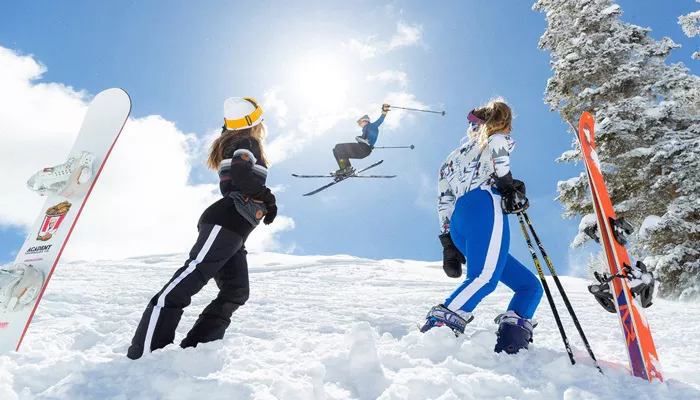Skiing is one of the most exhilarating winter sports, offering a variety of disciplines that cater to different skill levels and preferences. Among the most commonly discussed types of skiing are Alpine skiing and Downhill skiing. While these terms are sometimes used interchangeably, they actually refer to distinct skiing styles with unique characteristics.
In this article, we will explore the differences between Alpine skiing and Downhill skiing, covering aspects such as equipment, techniques, terrain, competitive aspects, and accessibility. Whether you’re a beginner looking to get started or an experienced skier curious about the nuances between these two styles, this guide will help clarify their distinctions.
What Is Alpine Skiing?
Definition and Overview
Alpine skiing is a broad term that encompasses all types of skiing conducted on groomed slopes with fixed-heel bindings. It includes various disciplines, such as recreational skiing, competitive skiing, and freestyle skiing.
Key Features of Alpine Skiing
Fixed-heel bindings: Unlike Nordic skiing, where the heel is free to lift, Alpine skiing uses bindings that securely attach the boot to the ski.
Groomed slopes: Alpine skiing is primarily performed on designated ski runs, which are maintained to provide a smooth skiing experience.
Gravity-assisted movement: Skiers rely on gravity to descend slopes, with ski lifts or gondolas used to reach the top of the mountain.
Multiple disciplines: Alpine skiing includes various styles such as Slalom, Giant Slalom, Super-G, and Freestyle skiing.
Equipment Used in Alpine Skiing
Skis: Alpine skis are designed with a rigid construction and sidecuts to facilitate carving turns on groomed slopes.
Boots: Stiff, high-cut ski boots provide support and control.
Bindings: Fixed-heel bindings ensure stability and prevent unnecessary movement.
Poles: Used for balance, timing, and assisting in turns.
Protective Gear: Helmets, goggles, and sometimes padded clothing for safety.
What Is Downhill Skiing?
Definition and Overview
Downhill skiing is a specific competitive discipline within Alpine skiing that focuses on high-speed descents. It is one of the five Alpine skiing events recognized in the Winter Olympics, alongside Slalom, Giant Slalom, Super-G, and Alpine Combined.
Key Features of Downhill Skiing
High speeds: Downhill skiing is the fastest form of Alpine skiing, with speeds exceeding 80–100 mph (130–160 km/h) in professional races.
Minimal turns: Unlike Slalom and Giant Slalom, which emphasize sharp, controlled turns, Downhill skiing features fewer, wider turns to maintain speed.
Longer, steeper courses: Downhill ski courses are significantly longer and steeper than those used for other Alpine skiing disciplines.
Timed competition: Downhill skiing is purely time-based, meaning the fastest skier to complete the course wins.
Equipment Used in Downhill Skiing
Longer, heavier skis: Downhill skis are designed for speed, with extra length for stability at high velocities.
Aerodynamic suits: Skiers wear specially designed suits that reduce air resistance.
High-performance boots: Designed for optimal power transfer and control at high speeds.
Protective gear: Helmets, back protectors, and padded suits are crucial due to the extreme speeds and risks of high-impact crashes.
Key Differences Between Alpine And Downhill Skiing
| Feature | Alpine Skiing | Downhill Skiing |
| Definition | General category of skiing on groomed slopes | Competitive skiing discipline focused on speed |
| Speed | Moderate to high, depending on style | Extremely high (80+ mph) |
| Terrain | Groomed slopes with various difficulty levels | Long, steep race courses |
| Turns | Varies by discipline (slalom, freestyle, etc.) | Minimal turns to maximize speed |
| Equipment | Standard Alpine skis and gear | Specialized long skis, aerodynamic suits |
| Competition | Includes Slalom, Giant Slalom, Super-G, Freestyle | Strictly a timed racing event |
| Accessibility | Available for all skill levels, including recreational skiers | Limited to professional and highly skilled racers |
Which One Is Right for You?
Choosing Alpine Skiing
If you’re a recreational skier, Alpine skiing is the best choice because it offers:
A variety of difficulty levels for beginners to advanced skiers.
The ability to enjoy different styles, including Slalom, Freestyle, and Giant Slalom.
Ski resorts worldwide cater to Alpine skiing with groomed trails, lifts, and rental equipment.
Choosing Downhill Skiing
Downhill skiing is best suited for elite athletes and advanced skiers who:
Have extensive skiing experience and excellent control at high speeds.
Are interested in competitive skiing and professional racing.
Have access to specialized training facilities and race courses.
Conclusion
While both Alpine skiing and Downhill skiing fall under the broader category of downhill sports, they serve different purposes and cater to different levels of expertise. Alpine skiing is a versatile, widely accessible sport suitable for recreational and competitive skiers alike, while Downhill skiing is a high-speed, professional discipline designed for elite athletes.
Understanding these differences will help you choose the best skiing experience based on your skill level, preferences, and goals. Whether you want to enjoy a leisurely descent down a groomed trail or push your limits in high-speed racing, skiing offers an exciting and rewarding winter sport for all enthusiasts.

